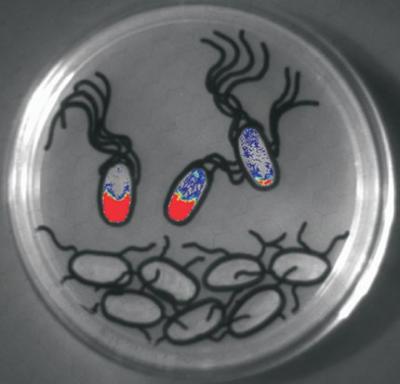Brian Ahmer
Professor of Microbial Infection & Immunity
710 Biomedical Research Tower
Areas of Expertise
- Detection of microbes and host environment by Salmonella
Education
- B.S. Colorado State University, 1990
- Ph.D. Washington State University, 1994
- Postdoc, Oregon Health Sciences University, 1994-1999

Research Interests
We are studying how Salmonella thrives in the host environment. We are currently focusing on three projects:
Detection of other microbes by Salmonella
Some bacteria use pheromones (N-acylhomoserine lactones or AHLs) to determine their population density. Salmonella does not make AHLs but it can detect the AHLs produced by other bacteria. We hypothesized that Salmonella would detect AHLs made by the normal intestinal microbiota and use this information to adjust its gene expression accordingly. Surprisingly, we discovered that the normal gut microbiota does not make AHLs and instead, Salmonella is detecting the AHL production of other pathogens in the gut. Salmonella can detect the AHL production of Aeromonas hydrophila in turtles and Yersinia enterocolitica in mice. We are characterizing this same AHL detection system in E. coli, Klebsiella, Enterobacter and other closely related organisms.
Characterization of fructose-asparagine metabolism
We recently discovered that fructose-asparagine is a nutrient for Salmonella in the inflamed intestine. We are characterizing the enzymology and regulation of this system. During these studies we determined that inhibition of the FraB enzyme in the pathway causes the accumulation of a metabolite that is toxic to Salmonella. This makes FraB an interesting drug target. We are actively screening compounds to find inhibitors of FraB. Future projects include determining why fructose-asparagine is toxic to a Salmonella fraB mutant (what is the mechanism of intoxication?) and determining how Salmonella recovers from these effects and how Salmonella might become resistant to FraB inhibitors.
A multi-omics approach to studying infection
We are starting a new project in collaboration with the Kelly Wrighton and Vicki Wysocki labs in which we characterize Salmonella infection of the mouse using several omics technologies. We will characterize the effect of Salmonella on the intestinal microbial community using 16S profiling and shotgun metagenomics; we will characterize the gene expression of Salmonella and the rest of the community using metatranscriptomics; and we will characterize the metabolites in the system using metabolomics. This will all be done at multiple time points to obtain a dynamic view of the infection. Integration of this data will generate large numbers of testable hypotheses. Future projects will include testing these hypotheses by constructing Salmonella mutants to see how they behave in various mouse models, including gnotobiotic mouse models (mice with a defined microbial community composition).
Relavant Publications
- Jitesh A. Soares and Brian M. M. Ahmer. 2011. Detection of acyl-homoserine lactones by Escherichia and Salmonella. Current Opinion in Microbiology 14(2):188-193.
- Fabien Habyarimana, Anice Sabag-Daigle, and Brian M. M. Ahmer. 2014. The sdiA-regulated gene srgE encodes a type III secreted effector. Journal of Bacteriology 196:2301-2312.
- Matthew C. Swearingen, Anice Sabag-Daigle, and Brian M. M. Ahmer. 2013. Are there acyl-homoserine lactones within mammalian intestines? Journal of Bacteriology 195:173-179.
- Mohamed M. Ali, David L. Newsom, Juan F. Gonzalez, Anice Sabag-Daigle, Christopher Stahl, Brandi Steidley, Judith Dubena, Jessica L. Dyszel, Jenee N. Smith, Yakhya Dieye, Razvan Arsenescu, Prosper N. Boyaka, Steven Krakowka, Tony Romeo, Edward J. Behrman, Peter White, and Brian M. M. Ahmer. 2014. Fructose-asparagine is a primary nutrient during growth of Salmonella in the inflamed intestine. PLoS Pathogens 10(6): e1004209.
- Anice Sabag-Daigle, Jessica L. Dyszel, Juan F. Gonzalez, Mohamed M. Ali, and Brian M. M. Ahmer. 2015. Identification of sdiA-regulated genes in a mouse commensal strain of Enterobacter cloacae. Frontiers in Cellular and Infection Microbiology 5:47.
- Anice Sabag-Daigle, Henry M. Blunk, Juan F. Gonzalez, Brandi L. Steidley, Prosper N. Boyaka, and Brian M. M. Ahmer. 2016. The use of attenuated but metabolically competent Salmonella as a probiotic to prevent or treat Salmonella infection. Infection and Immunity 84:2131-2141.
- Anice Sabag-Daigle, Henry M. Blunk, Anindita Sengupta, Jikang Wu, Alexander J. Bogard, Mohamed M. Ali, Christopher Stahl, Vicki H. Wysocki, Venkat Gopalan, Edward J. Behrman, and Brian M. M. Ahmer. 2016. A metabolic intermediate of the fructose-asparagine utilization pathway inhibits growth of a Salmonella fraB mutant. Scientific Reports 6: 28117.
- Jikang Wu, Anice Sabag-Daigle, Thomas O. Metz, Brooke L. Deatherage Kaiser, Venkat Gopalan, Edward J. Behrman, Vicki H. Wysocki, and Brian M. M. Ahmer. 2018. Measurement of fructose-asparagine concentrations in human and animal foods. Journal of Agricultural and Food Chemistry, 66(1): 212–217.
- Anice Sabag-Daigle, Jikang Wu, Mikayla A. Borton, Anindita Sengupta, Venkat Gopalan, Kelly C. Wrighton, Vicki H. Wysocki, and Brian M. M. Ahmer. 2018. Identification of bacterial species that can utilize fructose-asparagine. Applied and Environmental Microbiology, 84(5): AEM.01957-17.
- Wu J, Sabag-Daigle A, Borton MA, Kopp LFM, Szkoda BE, Deatherage Kaiser BL, Lindemann SR, Renslow RS, Wei S, Nicora CD, Weitz KK, Kim Y-M, Adkins JN, Metz TO, Boyaka P, Gopalan V, Wrighton KC, Wysocki VH, Ahmer BMM. 2018. Salmonella-mediated inflammation eliminates competitors for fructose-asparagine in the gut. Infect Immun, 86(5): IAI.00945–17.
The all-time favorite:
- Ali MM, Newsom DL, Gonzalez JF, Sabag-Daigle A, Stahl C, Steidley B, Dubena J, Dyszel JL, Smith JN, Dieye Y, Arsenescu R, Boyaka PN, Krakowka S, Romeo T, Behrman EJ, White P, & Ahmer BMM. 2014. Fructose-asparagine is a primary nutrient during growth of Salmonella in the inflamed intestine. PLOS Pathogens10(6): e1004209.
